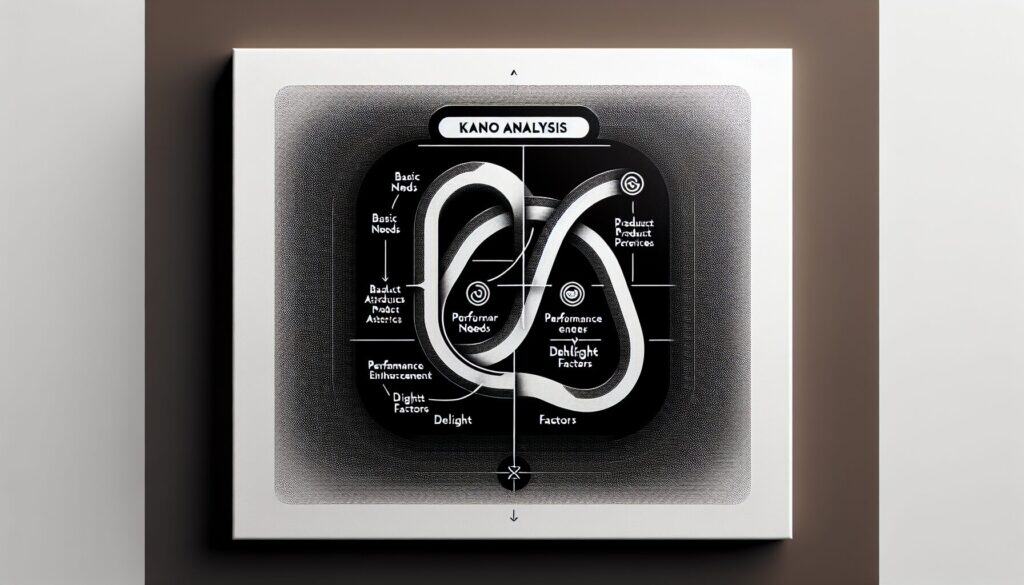To identify and categorize customer preferences for product features, distinguishing between those that satisfy basic needs, enhance performance, or delight customers.
- المنهجيات: العملاء والتسويق, الأفكار, تصميم المنتج
Kano Analysis (Kano Model)

Kano Analysis (Kano Model)
- تجربة العملاء, تخطيط رحلة العميل, التفكير التصميمي, ابتكار, تطوير المنتجات, إدارة المنتجات, نشر وظائف الجودة (QFD), تجربة المستخدم (UX), القيمة المقترحة
الهدف:
كيفية استخدامه:
- Customers are surveyed using a specific pair of questions (functional and dysfunctional forms) for each feature. Responses are then mapped to categories: Must-be, Performance, Attractive (Delighters), Indifferent, and Reverse qualities.
الايجابيات
- Helps prioritize feature development based on customer impact, identifies unspoken customer needs (delighters), avoids over-investing in features with low impact, provides a framework for understanding customer satisfaction dynamics.
سلبيات
- Requires careful survey design and administration, data analysis can be complex, customer preferences can change over time, interpretation of results needs context and can be subjective.
الفئات:
- العملاء والتسويق, الأفكار, تصميم المنتج, الجودة
الأفضل لـ
- Prioritizing product features, understanding customer expectations, and identifying opportunities for innovation by focusing on attributes that drive customer satisfaction and delight.
Kano Analysis is particularly advantageous during the early phases of product development, where understanding customer preferences can significantly influence design decisions and resource allocation. Industries such as technology, automotive, consumer electronics, and healthcare frequently apply this methodology to gauge how different features align with user expectations. Participation typically involves cross-functional teams, including designers, engineers, marketing specialists, and customer service representatives, who collaborate to gather and interpret customer feedback. The insights derived from the Kano Model allow teams to identify which features are standard essentials, such as battery life in electronics, which must be met to avoid dissatisfaction, and which features can delight users, like innovative user interfaces or unique aesthetic finishes that exceed basic expectations. This proactive approach can lead to strategic innovations that may not have been initially considered, as it reveals latent customer desires that can set a product apart from competitors. Furthermore, organizations can avoid misallocation of resources by recognizing features classified as indifferent or reverse qualities, thereby ensuring that investment in product development is concentrated on attributes that truly enhance user satisfaction. As research is conducted, methodologies like surveys can be utilized effectively to segment customer responses, providing granular insights that lay the groundwork for iterative product refinements.
الخطوات الرئيسية لهذه المنهجية
- Develop a list of product features or attributes for evaluation.
- Formulate pairs of questions for each feature in both functional and dysfunctional formats.
- Administer the survey to customers, collecting their responses.
- Analyze customer responses by mapping them to the Kano categories: Must-be, Performance, Attractive, Indifferent, and Reverse.
- Prioritize features based on their categorization and customer impact.
- Identify opportunities for innovation and improvements through the analysis of delighters.
- Review and adjust product development strategies based on the Kano model results.
نصائح للمحترفين
- Incorporate qualitative data from customer interviews to enrich quantitative survey results, revealing deeper motivations behind preferences.
- Regularly iterate on the Kano analysis as market dynamics change, ensuring alignment with shifting customer expectations and competitive trends.
- Utilize cross-functional collaboration in interpreting Kano results to integrate diverse perspectives and uncover innovative solutions that resonate with users.
لقراءة عدة منهجيات ومقارنتها, نوصي باستخدام
> مستودع المنهجيات الشامل <
مع أكثر من 400 منهجية أخرى.
نرحب بتعليقاتكم على هذه المنهجية أو المعلومات الإضافية على قسم التعليقات أدناه ↓، وكذلك أي أفكار أو روابط متعلقة بالهندسة.
السياق التاريخي
1960
1980
1983
1990
1995
2000
2010
1950
1980
1980
1986
1994
1995
2000
(إذا كان التاريخ غير معروف أو غير ذي صلة، على سبيل المثال "ميكانيكا الموائع"، يتم تقديم تقدير تقريبي لظهوره الملحوظ)














منشورات ذات صلة
استبيانات الانزعاج العضلي الهيكلي
الاختبار متعدد المتغيرات (MVT)
تحليل الانحدار المتعدد
أنظمة التقاط الحركة
طريقة MoSCoW
اختبار متوسط المزاج